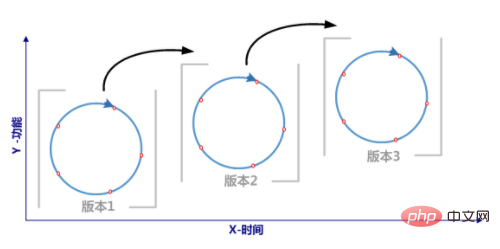What does iterative relationship mean?
The iterative relationship means the activity of repeating the feedback process. The purpose is usually to approximate the desired goal or result. Each repetition of the process is called an [iteration], and the results obtained from each iteration will be as the initial value for the next iteration.

The iterative relationship means:
Iteration: is an activity that repeats the feedback process, usually for the purpose of Approach a desired goal or outcome. Each repetition of the process is called an "iteration", and the result of each iteration serves as the initial value for the next iteration.
The process of repeatedly executing a series of calculation steps to find the following quantities from the previous quantities. Each result of this process is obtained by applying the same operation steps to the previous result. For example, use the iterative method* to find the solution to a certain mathematical problem.
Repeating a subroutine* (a set of instructions) that needs to be executed repeatedly in a specific computer program, that is, repeatedly executing the loop in the program until a certain condition is met, is also called iteration.

Extended information:
Using iterative algorithms to solve problems requires the following three aspects:
1. Determine variables
In problems that can be solved by iterative algorithms, there is at least one variable that directly or indirectly continuously derives new values from old values. This variable is the iteration variable.
2. Establish a relationship
The so-called iterative relationship refers to the formula (or relationship) of how to derive the next value from the previous value of a variable. The establishment of iterative relations is the key to solving iterative problems, which can usually be accomplished using recursion or backward reasoning.
3. Process control
The iteration process cannot be ended and the iteration process can be repeated endlessly. The control of the iterative process can usually be divided into two situations: one is that the required number of iterations is a certain value and can be calculated; the other is that the required number of iterations cannot be determined.
For the former case, a fixed number of loops can be constructed to control the iterative process; for the latter case, it is necessary to further analyze the conditions used to end the iterative process.
The above is the detailed content of What does iterative relationship mean?. For more information, please follow other related articles on the PHP Chinese website!

Hot AI Tools

Undresser.AI Undress
AI-powered app for creating realistic nude photos

AI Clothes Remover
Online AI tool for removing clothes from photos.

Undress AI Tool
Undress images for free

Clothoff.io
AI clothes remover

AI Hentai Generator
Generate AI Hentai for free.

Hot Article

Hot Tools

Notepad++7.3.1
Easy-to-use and free code editor

SublimeText3 Chinese version
Chinese version, very easy to use

Zend Studio 13.0.1
Powerful PHP integrated development environment

Dreamweaver CS6
Visual web development tools

SublimeText3 Mac version
God-level code editing software (SublimeText3)

Hot Topics
 1381
1381
 52
52
 AI technology accelerates iteration: large model strategy from Zhou Hongyi's perspective
Jun 15, 2023 pm 02:25 PM
AI technology accelerates iteration: large model strategy from Zhou Hongyi's perspective
Jun 15, 2023 pm 02:25 PM
Since this year, Zhou Hongyi, the founder of 360 Group, has been inseparable from one topic in all his public speeches, and that is artificial intelligence large models. He once called himself "the evangelist of GPT" and was full of praise for the breakthroughs achieved by ChatGPT, and he was firmly optimistic about the resulting AI technology iterations. As a star entrepreneur who is good at expressing himself, Zhou Hongyi's speeches are often full of witty remarks, so his "sermons" have also created many hot topics and indeed added fuel to the fire of large AI models. But for Zhou Hongyi, being an opinion leader is not enough. The outside world is more concerned about how 360, the company he runs, responds to this new wave of AI. In fact, within 360, Zhou Hongyi has already initiated a change for all employees. In April, he issued an internal letter requesting every employee and every employee of 360
 Adventures in Loops and Iteration: An Adventure in Python Code
Feb 19, 2024 pm 08:48 PM
Adventures in Loops and Iteration: An Adventure in Python Code
Feb 19, 2024 pm 08:48 PM
Loops and Iterations: Core Concepts in Programming Loops and iterations are essential concepts in programming that allow a program to repeatedly execute a set of instructions. Loops are used to explicitly specify the number of repetitions, while iterations are used to iterate over the elements in a collection or data structure. Types of Loops There are three main types of loops: 1. for loop A for loop is used to execute a block of code when you know the number of repetitions. Its syntax is as follows: for (initialization; condition; increment/decrement) {//code block to be executed repeatedly} For example, the following for loop prints the numbers 1 to 10: for(inti=1;i
 Iterate over TreeMap in reverse order in Java
Aug 21, 2023 pm 01:05 PM
Iterate over TreeMap in reverse order in Java
Aug 21, 2023 pm 01:05 PM
TreeMap is a class of JavaCollectionFramework that implements the NavigableMap interface. It stores the map's elements in a tree structure and provides an efficient way to store key-value pairs in sorted order. In other words, it always returns elements in ascending order. However, Java provides several methods for traversing a TreeMap in descending order. In this article, we will explore the method of traversing a TreeMap in reverse order. Iterate over a TreeMap in reverse order in Java We will print the elements of a TreeMap in reverse order using the following method: Using TreeMap.descendingMap() method Using TreeMap.de
 Avoid iterative recursion traps in PHP language development
Jun 10, 2023 pm 12:24 PM
Avoid iterative recursion traps in PHP language development
Jun 10, 2023 pm 12:24 PM
Avoid iteration and recursion traps in PHP language development Iteration and recursion are two different process control methods in programming. Their use depends on the actual application scenario and the developer's coding habits. In PHP development, the use of iteration and recursion is common, but they can also have pitfalls, leading to inefficient code, errors, and other problems. Therefore, you need to pay attention to some techniques during the development process to avoid the iterative recursion trap. Introduction to Iteration and Recursion Iteration and recursion are loop structures used to execute the same block of code multiple times. The basic idea of iteration
 How to use the fileinput module for file iteration in Python 3.x
Jul 29, 2023 pm 11:45 PM
How to use the fileinput module for file iteration in Python 3.x
Jul 29, 2023 pm 11:45 PM
How to use the fileinput module for file iteration in Python3.x In Python programming, we often need to operate files, such as reading file contents, writing file contents, etc. When processing multiple files, the fileinput module can be used to easily perform file iteration operations. This article will introduce how to use the fileinput module for file iteration in Python3.x and provide code examples. The fileinput module is the Python standard library
 Learn how to implement jQuery iteration from scratch
Feb 29, 2024 am 09:45 AM
Learn how to implement jQuery iteration from scratch
Feb 29, 2024 am 09:45 AM
To learn the implementation method of jQuery iteration from scratch, you need specific code examples. jQuery is a popular JavaScript library that is widely used in web development. Among them, iteration is one of the commonly used operations in jQuery. Through iteration, a set of elements can be traversed and corresponding operations performed. This article will introduce how to learn the implementation of jQuery iteration from scratch, focusing on the basic principles of iteration and specific code examples. 1. Basic principles of iteration In jQuery, the implementation of iteration mainly relies on
 How to use loop statements to implement iterative calculations in Java
Oct 18, 2023 am 10:40 AM
How to use loop statements to implement iterative calculations in Java
Oct 18, 2023 am 10:40 AM
How to use loop statements to implement iterative calculations in Java. In programming, we often need to perform some repetitive calculations or operations. At this time, loop statements play an important role. In Java, there are three forms of loop statements: for loop, while loop and do-while loop. These loop statements can help us implement iterative calculations, that is, through multiple loops to gradually approach the desired result. The following will introduce in detail how to use these loop statements to implement iterative calculations in Java, and give corresponding code examples.
 Python loops and iterations: a comprehensive analysis of their similarities and differences
Feb 19, 2024 pm 02:54 PM
Python loops and iterations: a comprehensive analysis of their similarities and differences
Feb 19, 2024 pm 02:54 PM
Loops and Iterations: Concept Analysis A loop is a control structure that allows a block of code to be executed repeatedly a specified number of times or until a specific condition is met. Python provides a variety of loop types, including for loops, while loops and do-while loops. On the other hand, iteration is an abstract concept that represents the process of traversing the elements of a sequence in order. Python provides tools such as iterators and generators to implement iteration. Loop vs. Iteration: Similarities and Differences Execution Mechanism: Loops explicitly control the execution flow, while iterations are performed implicitly through iterator objects. State management: Loops maintain their own state (such as counters or conditions), while iterators encapsulate state management. Usage scenarios: Loops are suitable for times that need to be repeated a fixed number of times or until the



